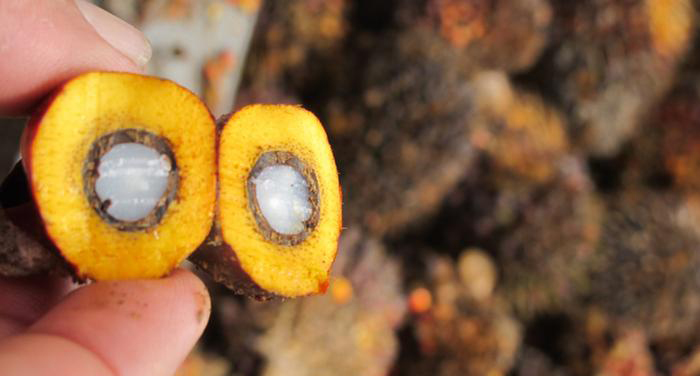Until recently, palm oil was labeled “vegetable oil” on ingredients lists. A new regulation is changing that: if products contain palm oil, they will be labeled as such.

Whether it’s soup, chocolate, lipstick, soap or washing powder – all contain palm oil. But their product descriptions simply mention “vegetable fat” or “vegetable oil.” Also included in that umbrella definition: Olive oil, rape seed oil and linseed oil, all of which are healthy vegetable oils and important sources of energy. Our brain, nervous system and metabolism need vegetable fat or oil, as they contain fatty acids that our body can’t produce by itself.
But most consumers are unaware that the generic “vegetable oil” label can also refer to palm oil, a product from the fruit pulp of oil palms.
Being healthy isn’t enough
Very often, new palm oil plantations result in the clearing of rainforest. Researchers at Princeton University have shown that more than half of the palm oil plantations in Indonesia and Malaysia are located in areas where there used to be rainforest. So by choosing a specific product, the consumer unwittingly has an impact on deforestation of rainforest and the fate of endangered species like orangutans or tigers.
So far it hasn’t been easy for consumers to choose the products consciously and to identify palm oil products. According the World Wildlife Fund (WWF), every second product in a supermarket contains palm oil, but only very few have been listing it as such.
This will soon change. A new EU restriction obliges producers to put palm oil on the ingredients list explicitly. It’s a measure that has sparked hope amongst environmental organizations.
“We hope that this is gives incentives for producers to stop using palm oil, or to use sustainably produced palm oil,” says Roland Gramling at WWF Germany.
Beyond conventional palm oil, with all its negative environmental and social impacts, there is sustainable palm oil certified by the Roundtable for Sustainable Palm Oil (RSPO) – “Not ultimate solution,” says Gramling, “but at least it reaches a minimum standard.”
n order to have their palm oil certified as sustainable, producers must refrain from using certain pesticides, provide working standard for their employees and avoid clearing protected areas of rainforest for new plantations.
A bitter aftertaste
Today, just 18 percent of the palm oil on the market is RSPO certified.
“Consumers don’t buy it,” says the WWFs Gramling.
The problem is that if palm oil is not even mentioned on the packaging of the product, the RSPO-certificate stating that it is sustainable palm oil is not either. Under these circumstances, how are consumers supposed to consciously choose the more environmentally friendly palm oil?
That’s why Gramling is calling for a regulation requiring companies to declare whether palm oil used in a product is organic or not.
Maike Förster, a biologist and scientific advisor at SAVE Wildlife Conservation Fund, isn’t very happy with the current situation, either. To her, getting a RSPO-certificate is a kind of “greenwashing.”
“The idea is good, but it is hard to punish offenders,” she says.
According to her, loopholes are still too big, so there should be more guidelines and sanctions put in place.
Few alternatives to palm oil
“When it comes to food products, there are enough alternative products to palm oil,” says Förster. “But palm oil has got an unbeatable price.”
With liquid detergents and other products , however, things are different. Here, alternatives are still scarce.
“We should invest more in research,” Förster says.
Current regulations don’t offer incentives to do so, though. While consumers are now able to choose to buy palm-oil-free products, the new regulation does not concern soaps and other beauty products.
“Even as a biologist, it is hard for me to name all the generic titles under which palm oil is being hidden here,” Förster says.
Förster’s organization, SAVE, has developed a database of palm-oil-free products. Around 3,800 are listed.
“In addition, we’re planning to develop an app, so that consumers get the information as soon as possible.”
This database – and the new obligation to label ingredients already – has already lead to more transparency on the market.
“I think this creates new consciousness amongst consumers,” says Gramling at WWF. “Something is going to change.”
